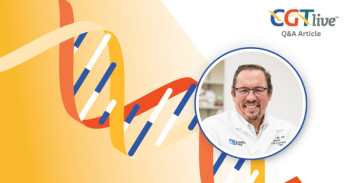
Axi-Cel Demonstrates Promising Efficacy and Acceptable Safety in CNS Lymphoma
A complete response rate of 67% was reported and no treatment-limiting toxicity occurred.
Axicabtagene ciloleucel (axi-cel) has demonstrated promising efficacy and acceptable safety in patients with relapsed/refractory (r/r) primary and secondary central nervous system (CNS) lymphoma, according to data from a phase 1 clinical trial (NCT04608487) presented in an oral session at the
Among the 9 patients included in the data presented, the unconfirmed complete response (uCR)/CR rate was 67%, the median duration of response was 11.3 months, median progression-free survival was 11.5 months, and estimated median overall survival was 19 months. The best overall response rate was 78%, and at 6 months the overall response rate was 78%. Median follow-up ranged from 3.0 months to 19.0 months (median, 11.3), and the median time to best response was 3 months.
In terms of safety, there were no treatment-limiting toxicities. One serious adverse event (AE), a case of staphylococcus meningitis related to an Ommaya infection, occurred and required explant. There were 8 cases of cytokine release syndrome (CRS), but none of these cases were grade 3 or higher. Four cases of immune effector cell-associated neurotoxicity syndrome (ICANS) occurred, with 3 of the cases being grade 3. No grade 4 cases of ICANS occurred. There were 3 patients who experienced cases of prolonged grade 3 neutropenia, and 1 of these patients also experienced a case of prolonged grade 3 thrombocytopenia. All of these cases lasted at least 1 month but resolved by 3 months. Two patient deaths occurred during the trial as a result of disease progression.
“The patients with grade 3 neurologic toxicity included 1 patient with secondary CNS lymphoma, who had previously had a very large burden of disease, and 1 patient with primary CNS lymphoma, who was diagnosed with a hospital-acquired COVID infection in the days following the onset of her neurologic symptoms,” presenter and first author Caron A. Jacobson, MD, medical director, Immune Effector Cell Therapy Program, Dana-Farber Cancer Institute, mentioned during her presentation. “The median time to onset of neurologic toxicity was 3 and a half days, which was probably an early estimate for this cohort because many of these patients develop neurologic symptoms in the setting of having fever for CRS, and true neurologic toxicity probably started later. But the median duration of neurologic toxicity even accounting for that early onset was 5 and a half days.”
Patients in the study were divided across 2 cohorts, with cohort 1 including patients (n=9) with primary or secondary CNS disease with no systemic involvement at the time of treatment and cohort 2 including patients (n=9) with secondary CNS
Only patients from cohort 1 were included in the data presented. This group included 4 male patients and 5 female patients whose ages ranged from 33 to 74 years (median, 60). Six of the patients had primary CNS lymphoma and 3 of the patients had secondary CNS lymphoma. The number of prior systemic therapies received by the patients ranged from 1 to 6 (median, 2), and 4 patients were relpased after their last therapy while 5 were refractory to their last therapy. All of the included patients had parenchymal involvement and none had known double-hit or triple-hit lymphomas (unknown, 3). Stable steroid dosing was allowed during the pre-infusion period, but was decreased to 2 mg of dexamethasone daily or equivalent by the day of infusion. Three patients continued steroids from screening to treatment and 2 patients were on steroids at the time of infusion. Palliative targeted radiation therapy was received by 5 of the 9 patients immediately before screening.
“Perhaps surprisingly, axi-cel pharmocokinetics [here] mirrors that seen on the ZUMA-1 (NCT02348216) study, despite all patients not having systemic lymphoma at the time of infusion,” Jacobson noted, summarizing pharmacokinetics and biomarker data that were analyzed as part of the study. “There are key cytokine differences between CNS lymphoma and systemic lymphoma patients however, with the former having lower pre-treatment and peak ferritin levels and also higher peak post-treatment interferon gamma and IL-2 levels. CAR+ T-cells appear to preferentially traffic to the CNS where they're more commonly CD4+ and express activation markers, as well as an interferon gamma gene expression signature. These changes happen after entry into the CNS, but do not correlate with disease burden in the CNS. Further exploration of these findings could shed light both on mechanism of action of CAR-T cells, as well as on the pathophysiology of ICANS."
Jacobson concluded by noting that based on the results seen so far, the study design has been amended to combine all patients into a single cohort rather than dividing patients based on systemic involvement, and also stated that there are plans to enroll an additional 9 patients into this new combined cohort. She additionally noted that analysis of minimal residual disease, including evaluation of various biomarkers for response and resistance, remains ongoing. Jacobson stated that continued promising results would support the initiation of a phase 2 study.
For more coverage of ASH 2022,
REFERENCE
Jacobson, CA. A pilot study of axicabtageneciloleucel (axi-cel) for the treatment of relapsed/refractory primary and secondary central nervous system lymphoma (CNSL). Presented at: ASH 2022 Annual Meeting. December 10-12, 2022; New Orleans, LA. Abstract 440
Newsletter
Stay at the forefront of cutting-edge science with CGT—your direct line to expert insights, breakthrough data, and real-time coverage of the latest advancements in cell and gene therapy.































